Secure Reactive Microservices with Spring Cloud Gateway
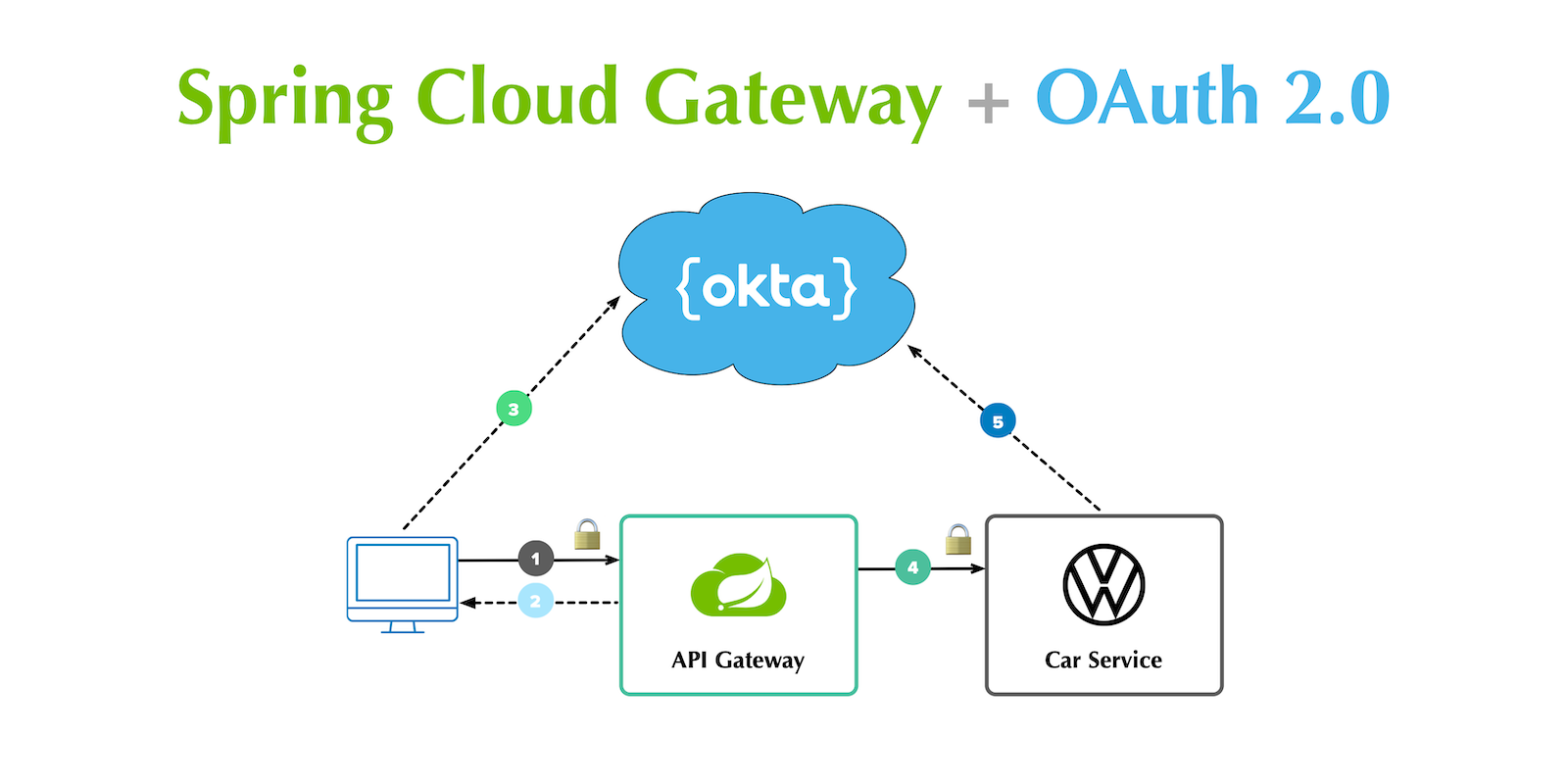
So you wanna go full reactive, eh? Great! Reactive programming is an increasingly popular way to make your applications more efficient. Instead of making a call to a resource and waiting on a response, reactive applications asynchronously receive a response. This allows them to free up processing power, only perform processing when necessary, and scale more effectively than other systems.
The Java ecosystem has its fair share of reactive frameworks, including Play Framework, Ratpack, Vert.x, and Spring WebFlux. Like Reactive programming, a microservices architecture can help large teams scale quickly and is possible to build using any of the awesome aforementioned frameworks.
Today I’d like to show you how you can build a reactive microservices architecture using Spring Cloud Gateway, Spring Boot, and Spring WebFlux. We’ll leverage Spring Cloud Gateway as API gateways are often important components in a cloud-native microservices architecture, providing the aggregation layer for all your backend microservices.
This tutorial shows you how to build a microservice with a REST API that returns a list of new cars. You’ll use Eureka for service discovery and Spring Cloud Gateway to route requests to the microservice. Then you’ll integrate Spring Security so only authenticated users can access your API gateway and microservice.
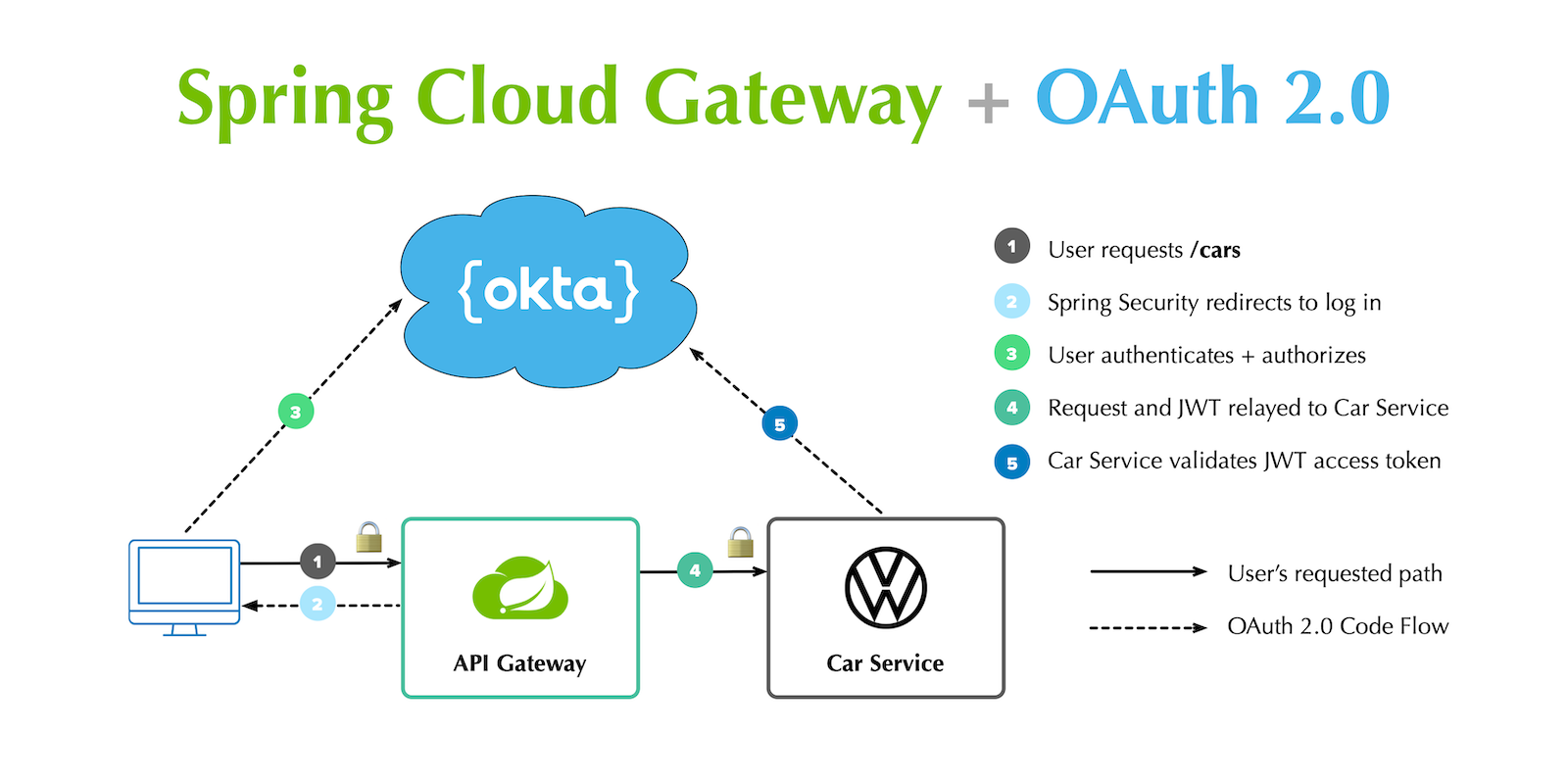
If you’d rather watch a video, I created a screencast of this blog post.
- Spring Cloud Gateway vs. Zuul
- Create a Spring Cloud Eureka Server Project
- Create a Spring Cloud Gateway Project
- Create a Reactive Microservice with Spring WebFlux
- Build a REST API with Spring WebFlux
- Use Spring Cloud Gateway with Reactive Microservices
- Secure Spring Cloud Gateway with OAuth 2.0
- Test Your Gateway with WebTestClient and JWT
- Secure Gateway to Microservice Communication
- Test Your Microservice with WebTestClient and JWT
- Mock JWT Support in Spring Security 5.2
- Relay the Access Token: Gateway to Microservice
- Learn More about Spring Cloud Gateway and Reactive Microservices with Spring
Spring Cloud Gateway vs. Zuul
Zuul is Netflix’s API gateway. First released in 2013, Zuul was not originally reactive, but Zuul 2 is a ground-up rewrite to make it reactive. Unfortunately, Spring Cloud does not support Zuul 2 and it likely never will.
Spring Cloud Gateway is now the preferred API gateway implementation from the Spring Cloud Team. It’s built on Spring 5, Reactor, and Spring WebFlux. Not only that, it also includes circuit breaker integration, service discovery with Eureka, and is much easier to integrate with OAuth 2.0!
Let’s dig in.
Create a Spring Cloud Eureka Server Project
Start by creating a directory to hold all your projects, for example, spring-cloud-gateway. Navigate to it in a terminal window and create a discovery-service project that includes Spring Cloud Eureka Server as a dependency.
http https://start.spring.io/starter.zip javaVersion==11 artifactId==discovery-service \
name==eureka-service baseDir==discovery-service bootVersion==2.3.10.RELEASE \
dependencies==cloud-eureka-server | tar -xzvf -
The command above uses HTTPie. I highly recommend installing it. You can also use curl. Run curl https://start.spring.io to see the syntax.
|
Add @EnableEurekaServer on its main class to enable it as a Eureka server.
import org.springframework.cloud.netflix.eureka.server.EnableEurekaServer;
@EnableEurekaServer
@SpringBootApplication
public class EurekaServiceApplication {...}Add the following properties to the project’s src/main/resources/application.properties file to configure its port and turn off Eureka registration.
server.port=8761
eureka.client.register-with-eureka=falseStart the project using ./mvnw spring-boot:run or by running it in your IDE.
Create a Spring Cloud Gateway Project
Next, create an api-gateway project that includes a handful of Spring Cloud dependencies.
http https://start.spring.io/starter.zip javaVersion==11 artifactId==api-gateway \
name==api-gateway baseDir==api-gateway bootVersion==2.3.10.RELEASE \
dependencies==actuator,cloud-eureka,cloud-feign,cloud-gateway,cloud-hystrix,webflux,lombok | tar -xzvf -We’ll come back to configuring this project in a minute.
Create a Reactive Microservice with Spring WebFlux
The car microservice will contain a significant portion of this example’s code because it contains a fully-functional REST API that supports CRUD (Create, Read, Update, and Delete).
Create the car-service project using start.spring.io:
http https://start.spring.io/starter.zip javaVersion==11 artifactId==car-service \
name==car-service baseDir==car-service bootVersion==2.3.10.RELEASE \
dependencies==actuator,cloud-eureka,webflux,data-mongodb-reactive,flapdoodle-mongo,lombok | tar -xzvf -The dependencies argument is interesting in this command. You can see that Spring WebFlux is included, as is MongoDB. Spring Data provides reactive drivers for Redis and Cassandra as well.
You may also be interested in R2DBC (Reactive Relational Database Connectivity) - an endeavor to bring a reactive programming API to SQL databases. I did not use it in this example because it’s not yet available on start.spring.io.
Build a REST API with Spring WebFlux
I’m a big fan of VWs, especially classic ones like the bus and the bug. Did you know that VW has a bunch of electric vehicles coming out in the next few years? I’m really excited by the ID Buzz! It has classic curves and is all-electric. It even has 350+ horsepower!
In case you’re not familiar with the ID Buzz, here’s a photo from Volkswagen.

Let’s have some fun with this API example and use the electric VWs for our data set. This API will track the various car names and release dates.
Add Eureka registration, sample data initialization, and a reactive REST API to src/main/java/…/CarServiceApplication.java:
package com.example.carservice;
import lombok.AllArgsConstructor;
import lombok.Data;
import lombok.NoArgsConstructor;
import lombok.extern.slf4j.Slf4j;
import org.springframework.boot.ApplicationRunner;
import org.springframework.boot.SpringApplication;
import org.springframework.boot.autoconfigure.SpringBootApplication;
import org.springframework.cloud.netflix.eureka.EnableEurekaClient;
import org.springframework.context.annotation.Bean;
import org.springframework.data.annotation.Id;
import org.springframework.data.mongodb.core.mapping.Document;
import org.springframework.data.mongodb.repository.ReactiveMongoRepository;
import org.springframework.http.HttpStatus;
import org.springframework.http.ResponseEntity;
import org.springframework.web.bind.annotation.*;
import reactor.core.publisher.Flux;
import reactor.core.publisher.Mono;
import java.time.LocalDate;
import java.time.Month;
import java.util.Set;
import java.util.UUID;
@EnableEurekaClient (1)
@SpringBootApplication
@Slf4j (2)
public class CarServiceApplication {
public static void main(String[] args) {
SpringApplication.run(CarServiceApplication.class, args);
}
@Bean (3)
ApplicationRunner init(CarRepository repository) {
// Electric VWs from https://www.vw.com/electric-concepts/
// Release dates from https://www.motor1.com/features/346407/volkswagen-id-price-on-sale/
Car ID = new Car(UUID.randomUUID(), "ID.", LocalDate.of(2019, Month.DECEMBER, 1));
Car ID_CROZZ = new Car(UUID.randomUUID(), "ID. CROZZ", LocalDate.of(2021, Month.MAY, 1));
Car ID_VIZZION = new Car(UUID.randomUUID(), "ID. VIZZION", LocalDate.of(2021, Month.DECEMBER, 1));
Car ID_BUZZ = new Car(UUID.randomUUID(), "ID. BUZZ", LocalDate.of(2021, Month.DECEMBER, 1));
Set<Car> vwConcepts = Set.of(ID, ID_BUZZ, ID_CROZZ, ID_VIZZION);
return args -> {
repository
.deleteAll() (4)
.thenMany(
Flux
.just(vwConcepts)
.flatMap(repository::saveAll)
)
.thenMany(repository.findAll())
.subscribe(car -> log.info("saving " + car.toString())); (5)
};
}
}
@Document
@Data
@NoArgsConstructor
@AllArgsConstructor
class Car { (6)
@Id
private UUID id;
private String name;
private LocalDate releaseDate;
}
interface CarRepository extends ReactiveMongoRepository<Car, UUID> { (7)
}
@RestController
class CarController { (8)
private CarRepository carRepository;
public CarController(CarRepository carRepository) {
this.carRepository = carRepository;
}
@PostMapping("/cars")
@ResponseStatus(HttpStatus.CREATED)
public Mono<Car> addCar(@RequestBody Car car) { (9)
return carRepository.save(car);
}
@GetMapping("/cars")
public Flux<Car> getCars() { (10)
return carRepository.findAll();
}
@DeleteMapping("/cars/{id}")
public Mono<ResponseEntity<Void>> deleteCar(@PathVariable("id") UUID id) {
return carRepository.findById(id)
.flatMap(car -> carRepository.delete(car)
.then(Mono.just(new ResponseEntity<Void>(HttpStatus.OK)))
)
.defaultIfEmpty(new ResponseEntity<>(HttpStatus.NOT_FOUND));
}
}| 1 | Add the @EnableEurekaClient annotation for service discovery |
| 2 | @Slf4j is a handy annotation from Lombok to enable logging in a class |
| 3 | ApplicationRunner bean to populate MongoDB with default data |
| 4 | Delete all existing data in MongoDB so new data is not additive |
| 5 | Subscribe to results so both deleteAll() and saveAll() are invoked |
| 6 | Car class with Spring Data NoSQL and Lombok annotations to reduce boilerplate |
| 7 | CarRepository interface that extends ReactiveMongoRepository, giving you CRUDability with hardly any code! |
| 8 | CarController class that uses CarRepository to perform CRUD actions |
| 9 | Spring WebFlux returns a Mono publisher for single objects |
| 10 | Return a Flex publisher for multiple objects |
| If you’re using an IDE to build your projects, you’ll need to setup Lombok for your IDE. |
You’ll also need to modify the car-service project’s application.properties to set its name and port.
spring.application.name=car-service
server.port=8081Run MongoDB
The easiest way to run MongoDB is to remove the test scope from the flapdoodle dependency in car-service/pom.xml. This will cause your app to start an embedded MongoDB dependency.
<dependency>
<groupId>de.flapdoodle.embed</groupId>
<artifactId>de.flapdoodle.embed.mongo</artifactId>
<!--<scope>test</scope>-->
</dependency>You can also install and run MongoDB using Homebrew.
brew tap mongodb/brew
brew install mongodb-community@4.2
mongodOr, use Docker:
docker run -d -it -p 27017:27017 mongoStream Data with WebFlux
This completes everything you need to do to build a REST API with Spring WebFlux.
"But wait!" you might say. "I thought WebFlux was all about streaming data?"
In this particular example, you can still stream data from the /cars endpoint, but not in a browser.
A browser has no way to consume a stream other than using Server-Sent Events or WebSockets. Non-browser clients however can get a JSON stream by sending an Accept header with a value of application/stream+json (thanks to Rajeev Singh for the tip).
You could test everything works at this point by firing up your browser and using HTTPie to make requests. However, it’s much better to write automated tests!
Test Your WebFlux API with WebTestClient
WebClient ships as part of Spring WebFlux and can be useful for making reactive requests, receiving responses, and populating objects with the payload. A companion class, WebTestClient, can be used to test your WebFlux API. It contains request methods that are similar to WebClient, as well as methods to check the response body, status, and headers.
Modify the src/test/java/…/CarServiceApplicationTests.java class in the car-service project to contain the code below.
package com.example.carservice;
import org.junit.jupiter.api.Test;
import org.springframework.beans.factory.annotation.Autowired;
import org.springframework.boot.test.context.SpringBootTest;
import org.springframework.http.MediaType;
import org.springframework.test.web.reactive.server.WebTestClient;
import reactor.core.publisher.Mono;
import java.time.LocalDate;
import java.time.Month;
import java.util.Collections;
import java.util.UUID;
@SpringBootTest(webEnvironment = SpringBootTest.WebEnvironment.RANDOM_PORT,
properties = {"spring.cloud.discovery.enabled = false"})
public class CarServiceApplicationTests {
@Autowired
CarRepository carRepository;
@Autowired
WebTestClient webTestClient;
@Test
public void testAddCar() {
Car buggy = new Car(UUID.randomUUID(), "ID. BUGGY", LocalDate.of(2022, Month.DECEMBER, 1));
webTestClient.post().uri("/cars")
.contentType(MediaType.APPLICATION_JSON_UTF8)
.accept(MediaType.APPLICATION_JSON_UTF8)
.body(Mono.just(buggy), Car.class)
.exchange()
.expectStatus().isCreated()
.expectHeader().contentType(MediaType.APPLICATION_JSON_UTF8)
.expectBody()
.jsonPath("$.id").isNotEmpty()
.jsonPath("$.name").isEqualTo("ID. BUGGY");
}
@Test
public void testGetAllCars() {
webTestClient.get().uri("/cars")
.accept(MediaType.APPLICATION_JSON_UTF8)
.exchange()
.expectStatus().isOk()
.expectHeader().contentType(MediaType.APPLICATION_JSON_UTF8)
.expectBodyList(Car.class);
}
@Test
public void testDeleteCar() {
Car buzzCargo = carRepository.save(new Car(UUID.randomUUID(), "ID. BUZZ CARGO",
LocalDate.of(2022, Month.DECEMBER, 2))).block();
webTestClient.delete()
.uri("/cars/{id}", Collections.singletonMap("id", buzzCargo.getId()))
.exchange()
.expectStatus().isOk();
}
}To prove it works, run ./mvnw test. Give yourself a pat on the back when your tests pass!
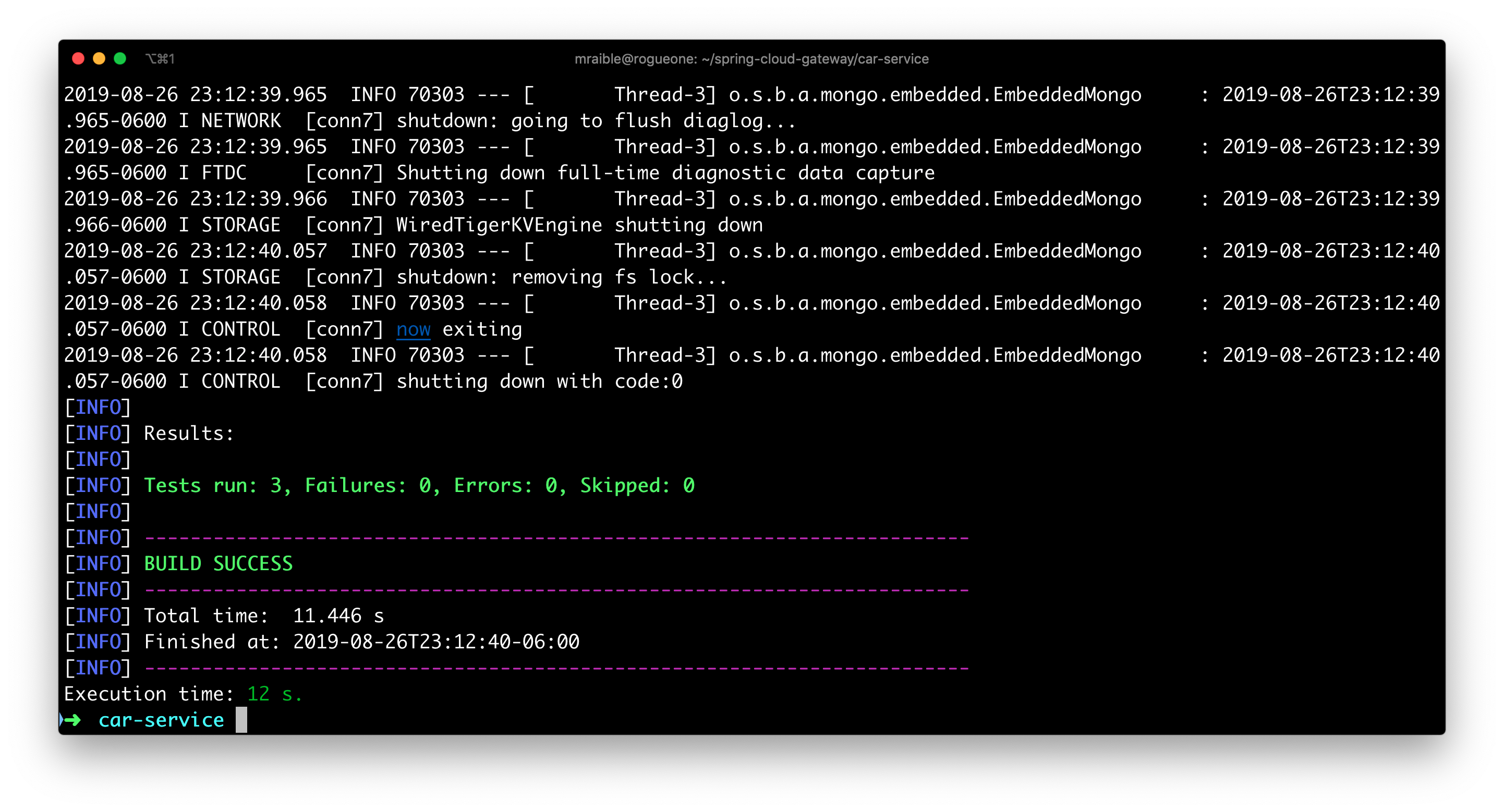
If you’re on Windows, use mvnw test.
|
Use Spring Cloud Gateway with Reactive Microservices
To edit all three projects in the same IDE window, I find it useful to create an aggregator pom.xml. Create a pom.xml file in the parent directory of your projects and copy the XML below into it.
<?xml version="1.0" encoding="UTF-8"?>
<project xmlns="http://maven.apache.org/POM/4.0.0" xmlns:xsi="http://www.w3.org/2001/XMLSchema-instance"
xsi:schemaLocation="http://maven.apache.org/POM/4.0.0 http://maven.apache.org/xsd/maven-4.0.0.xsd">
<modelVersion>4.0.0</modelVersion>
<groupId>com.okta.developer</groupId>
<artifactId>reactive-parent</artifactId>
<version>1.0.0-SNAPSHOT</version>
<packaging>pom</packaging>
<name>reactive-parent</name>
<modules>
<module>discovery-service</module>
<module>car-service</module>
<module>api-gateway</module>
</modules>
</project>After creating this file, you should be able to open it in your IDE as a project and navigate between projects easily.
In the api-gateway project, add @EnableEurekaClient to the main class to make it Eureka-aware.
import org.springframework.cloud.netflix.eureka.EnableEurekaClient;
@EnableEurekaClient
@SpringBootApplication
public class ApiGatewayApplication {...}Then, modify the src/main/resources/application.properties file to configure the application name.
spring.application.name=gatewayCreate a RouteLocator bean in ApiGatewayApplication to configure routes. You can configure Spring Cloud Gateway with YAML, but I prefer Java.
package com.example.apigateway;
import org.springframework.boot.SpringApplication;
import org.springframework.boot.autoconfigure.SpringBootApplication;
import org.springframework.cloud.gateway.route.RouteLocator;
import org.springframework.cloud.gateway.route.builder.RouteLocatorBuilder;
import org.springframework.cloud.netflix.eureka.EnableEurekaClient;
import org.springframework.context.annotation.Bean;
@EnableEurekaClient
@SpringBootApplication
public class ApiGatewayApplication {
public static void main(String[] args) {
SpringApplication.run(ApiGatewayApplication.class, args);
}
@Bean
public RouteLocator customRouteLocator(RouteLocatorBuilder builder) {
return builder.routes()
.route("car-service", r -> r.path("/cars")
.uri("lb://car-service"))
.build();
}
}After making these code changes, you should be able to start all three Spring Boot apps and hit http://localhost:8080/cars.
$ http :8080/cars
HTTP/1.1 200 OK
Content-Type: application/json;charset=UTF-8
transfer-encoding: chunked
[
{
"id": "ff48f617-6cba-477c-8e8f-2fc95be96416",
"name": "ID. CROZZ",
"releaseDate": "2021-05-01"
},
{
"id": "dd6c3c32-724c-4511-a02c-3348b226160a",
"name": "ID. BUZZ",
"releaseDate": "2021-12-01"
},
{
"id": "97cfc577-d66e-4a3c-bc40-e78c3aab7261",
"name": "ID.",
"releaseDate": "2019-12-01"
},
{
"id": "477632c8-2206-4f72-b1a8-e982e6128ab4",
"name": "ID. VIZZION",
"releaseDate": "2021-12-01"
}
]Add a REST API to Retrieve Your Favorite Cars
Create a /fave-cars endpoint that strips out cars that aren’t your favorite.
First, add a load-balanced WebClient.Builder bean.
@Bean
@LoadBalanced
public WebClient.Builder loadBalancedWebClientBuilder() {
return WebClient.builder();
}Then add a Car POJO and a FaveCarsController below the ApiGatewayApplication class in the same file.
public class ApiGatewayApplication {...}
class Car {...}
class FaveCarsController {...}Use WebClient to retrieve the cars and filter out the ones you don’t love.
@Data
class Car {
private String name;
private LocalDate releaseDate;
}
@RestController
class FaveCarsController {
private final WebClient.Builder carClient;
public FaveCarsController(WebClient.Builder carClient) {
this.carClient = carClient;
}
@GetMapping("/fave-cars")
public Flux<Car> faveCars() {
return carClient.build().get().uri("lb://car-service/cars")
.retrieve().bodyToFlux(Car.class)
.filter(this::isFavorite);
}
private boolean isFavorite(Car car) {
return car.getName().equals("ID. BUZZ");
}
}If you’re not using an IDE that auto-imports for you, you’ll want to copy/paste the following into the top of ApiGatewayApplication.java:
import org.springframework.web.bind.annotation.GetMapping;
import org.springframework.web.bind.annotation.RestController;
import org.springframework.web.reactive.function.client.WebClient;
import reactor.core.publisher.Flux;Restart your gateway app to see the http://localhost:8080/fave-cars endpoint only returns the ID Buzz.
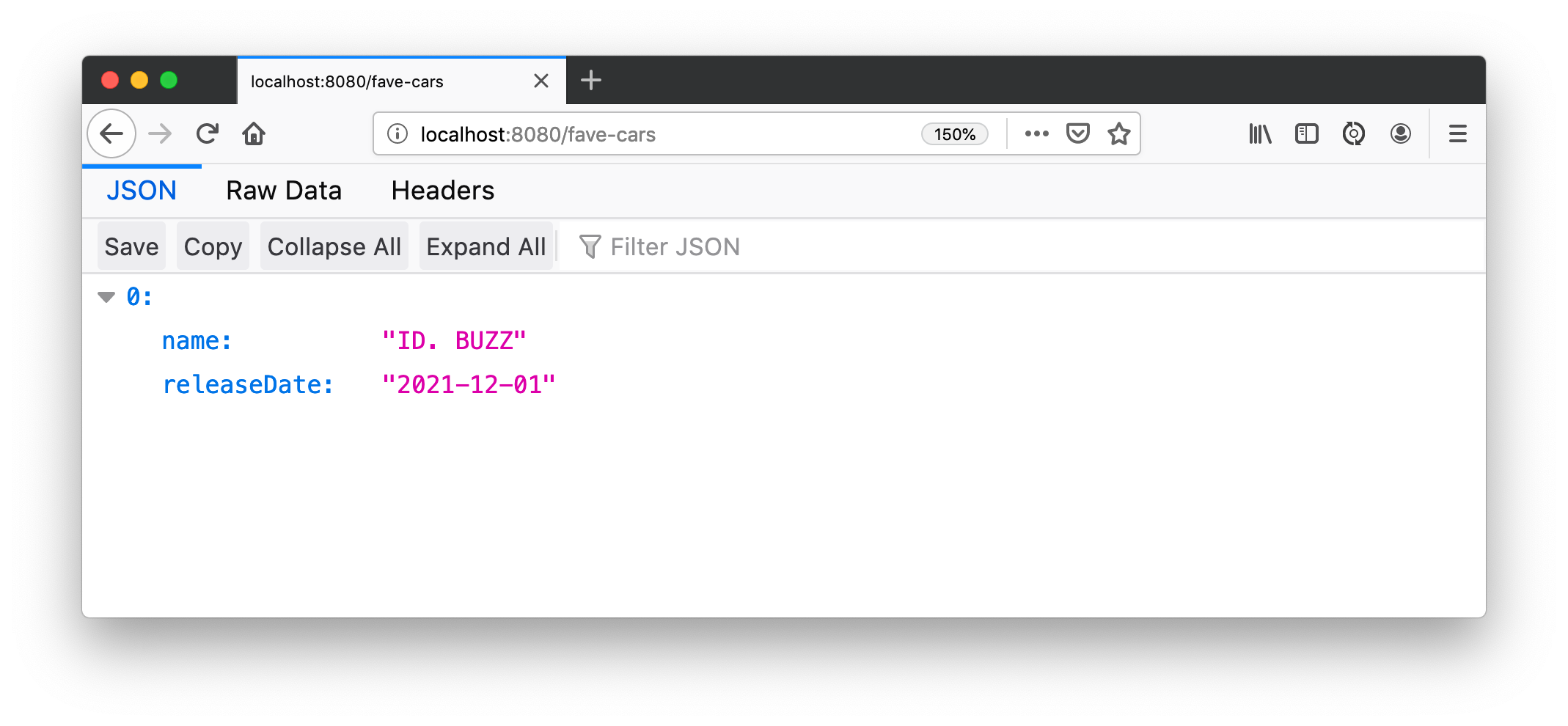
What about Failover with Hystrix?
Spring Cloud Gateway only supports Hystrix at the time of this writing. Spring Cloud deprecated direct support for Hystrix in favor of Spring Cloud Circuit Breaker. Unfortunately, this library hasn’t had a GA release yet, so I decided not to use it.
To use Hystrix with Spring Cloud Gateway, you can add a filter to your car-service route, like so:
.route("car-service", r -> r.path("/cars")
.filters(f -> f.hystrix(c -> c.setName("carsFallback")
.setFallbackUri("forward:/cars-fallback")))
.uri("lb://car-service/cars"))
.build();Then create a CarsFallback controller to handle the /cars-fallback route.
@RestController
class CarsFallback {
@GetMapping("/cars-fallback")
public Flux<Car> noCars() {
return Flux.empty();
}
}First, restart your gateway and confirm http://localhost:8080/cars works. Then shut down the car service, try again, and you’ll see it now returns an empty array. Restart the car service and you’ll see the list populated again.
You’ve built a resilient and reactive microservices architecture with Spring Cloud Gateway and Spring WebFlux. Now let’s see how to secure it!
What about Feign with Spring Cloud Gateway?
If you’d like to use Feign in a WebFlux app, see the feign-reactive project. I did not have a need for Feign in this particular example.
Secure Spring Cloud Gateway with OAuth 2.0
OAuth 2.0 is an authorization framework for delegated access to APIs. OIDC (or OpenID Connect) is a thin layer on top of OAuth 2.0 that provides authentication. Spring Security has excellent support for both frameworks and so does Okta!
You can use OAuth 2.0 and OIDC without a cloud identity provider by building your own server or by using an open-source implementation. However, wouldn’t you rather just use something that’s always on, like Okta?
In a terminal window, go to your api-gateway project’s directory.
Run the Okta Maven Plugin from your app’s folder:
./mvnw com.okta:okta-maven-plugin:registerAnswer a few questions (name, email, and company), and it will generate a new Okta developer account for you. If you already have an Okta account registered, use login instead of register.
Then, configure your Spring Boot application to use Okta for authentication:
./mvnw com.okta:okta-maven-plugin:spring-bootThis will set up a new OIDC application for you and write your Okta settings to your src/main/resources/application.properties file.
NOTE: You can also use the Okta Admin Console to create your app. See Create a Spring Boot App for more information.
Next, add the Okta Spring Boot starter and Spring Cloud Security to your gateway’s pom.xml:
<dependency>
<groupId>com.okta.spring</groupId>
<artifactId>okta-spring-boot-starter</artifactId>
<version>2.0.1</version>
</dependency>
<dependency>
<groupId>org.springframework.cloud</groupId>
<artifactId>spring-cloud-security</artifactId>
</dependency>This is all you need to do to add OIDC login with Okta! Restart your gateway app and navigate to http://localhost:8080/fave-cars in your browser to be redirected to Okta for user authorization.
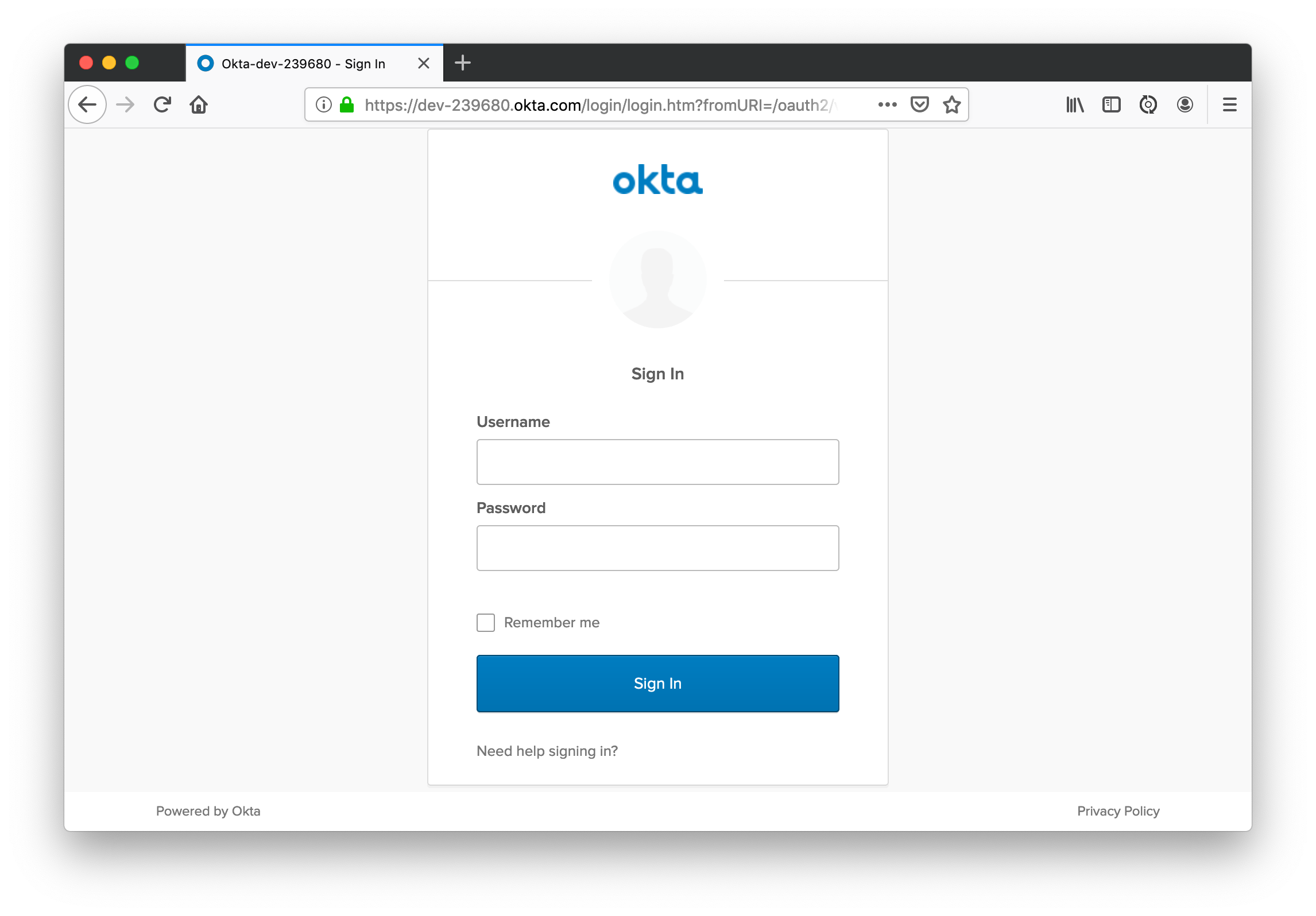
Make Your Gateway an OAuth 2.0 Resource Server
You likely won’t build the UI for your app on the gateway itself. You’ll probably use a SPA or mobile app instead. To configure your gateway to operate as a resource server (that looks for an Authorization header with a bearer token), add a new SecurityConfiguration class in the same directory as your main class.
package com.example.apigateway;
import org.springframework.context.annotation.Bean;
import org.springframework.security.config.annotation.method.configuration.EnableReactiveMethodSecurity;
import org.springframework.security.config.annotation.web.reactive.EnableWebFluxSecurity;
import org.springframework.security.config.web.server.ServerHttpSecurity;
import org.springframework.security.web.server.SecurityWebFilterChain;
@EnableWebFluxSecurity
@EnableReactiveMethodSecurity
public class SecurityConfiguration {
@Bean
public SecurityWebFilterChain securityWebFilterChain(ServerHttpSecurity http) {
// @formatter:off
http
.authorizeExchange()
.anyExchange().authenticated()
.and()
.oauth2Login()
.and()
.oauth2ResourceServer()
.jwt();
return http.build();
// @formatter:on
}
}CORS with Spring Cloud Gateway
If you’re using a SPA for your UI, you’ll want to configure CORS as well. You can do this by adding a CorsWebFilter bean to this class.
@Bean
CorsConfigurationSource corsConfigurationSource() {
CorsConfiguration corsConfig = new CorsConfiguration();
corsConfig.setAllowedOrigins(List.of("*"));
corsConfig.setMaxAge(3600L);
corsConfig.addAllowedMethod("*");
corsConfig.addAllowedHeader("*");
UrlBasedCorsConfigurationSource source = new UrlBasedCorsConfigurationSource();
source.registerCorsConfiguration("/**", corsConfig);
return source;
}Make sure your imports match the ones below.
import org.springframework.web.cors.CorsConfiguration;
import org.springframework.web.cors.reactive.CorsConfigurationSource;
import org.springframework.web.cors.reactive.UrlBasedCorsConfigurationSource;Spring Cloud Gateway’s documentation explains how to configure CORS with YAML or with WebFluxConfigurer. Unfortunately, I was unable to get either one to work.
With this CORS configuration, you’ll be able to access http://localhost:8080/cars from a SPA app on another server or port. If you want to provide access to /fave-cars, you’ll need to modify the faveCars() method to add an Authorization header.
import org.springframework.security.oauth2.client.OAuth2AuthorizedClient;
import org.springframework.security.oauth2.client.annotation.RegisteredOAuth2AuthorizedClient;
...
GetMapping("/fave-cars")
public Flux<car> faveCars(@RegisteredOAuth2AuthorizedClient("okta") OAuth2AuthorizedClient authorizedClient) {
return carClient.build().get().uri("lb://car-service/cars")
.header("Authorization", "Bearer " + authorizedClient.getAccessToken().getTokenValue())
.retrieve().bodyToFlux(Car.class)
.filter(this::isFavorite);
}Test Your Gateway with WebTestClient and JWT
If you configured CORS in your gateway, you can test it works with WebTestClient. Replace the code in ApiGatewayApplicationTests with the following.
package com.example.apigateway;
import org.junit.jupiter.api.Test;
import org.springframework.beans.factory.annotation.Autowired;
import org.springframework.boot.test.context.SpringBootTest;
import org.springframework.boot.test.mock.mockito.MockBean;
import org.springframework.http.HttpHeaders;
import org.springframework.security.oauth2.jwt.Jwt;
import org.springframework.security.oauth2.jwt.ReactiveJwtDecoder;
import org.springframework.test.web.reactive.server.WebTestClient;
import reactor.core.publisher.Mono;
import java.util.Collections;
import java.util.Map;
import java.util.function.Consumer;
import static org.mockito.ArgumentMatchers.anyString;
import static org.mockito.Mockito.when;
@SpringBootTest(webEnvironment = SpringBootTest.WebEnvironment.RANDOM_PORT,
properties = {"spring.cloud.discovery.enabled = false"})
public class ApiGatewayApplicationTests {
@Autowired
WebTestClient webTestClient;
@MockBean (1)
ReactiveJwtDecoder jwtDecoder;
@Test
public void testCorsConfiguration() {
Jwt jwt = jwt(); (2)
when(this.jwtDecoder.decode(anyString())).thenReturn(Mono.just(jwt)); (3)
WebTestClient.ResponseSpec response = webTestClient.put().uri("/")
.headers(addJwt(jwt)) (4)
.header("Origin", "http://example.com")
.exchange();
response.expectHeader().valueEquals("Access-Control-Allow-Origin", "*");
}
private Jwt jwt() {
return new Jwt("token", null, null,
Map.of("alg", "none"), Map.of("sub", "betsy"));
}
private Consumer<HttpHeaders> addJwt(Jwt jwt) {
return headers -> headers.setBearerAuth(jwt.getTokenValue());
}
}| 1 | Mock ReactiveJwtDecoder so you can set expectations and return mocks when it decodes |
| 2 | Create a new JWT |
| 3 | Return the same JWT when it’s decoded |
| 4 | Add the JWT to the Authorization header with a Bearer prefix |
I like how WebTestClient allows you to set the security headers so easily!
You’ve configured Spring Cloud Gateway to use OIDC login and function as an OAuth 2.0 resource server, but the car service is still available on port 8081. Let’s fix that so only the gateway can talk to it.
Secure Gateway to Microservice Communication
Add the Okta Spring Boot starter to car-service/pom.xml:
<dependency>
<groupId>com.okta.spring</groupId>
<artifactId>okta-spring-boot-starter</artifactId>
<version>2.0.1</version>
</dependency>Copy the okta.* properties from the gateway’s application.properties to the car service’s. Then create a SecurityConfiguration class to make the app an OAuth 2.0 resource server.
package com.example.carservice;
import com.okta.spring.boot.oauth.Okta;
import org.springframework.context.annotation.Bean;
import org.springframework.security.config.annotation.method.configuration.EnableReactiveMethodSecurity;
import org.springframework.security.config.annotation.web.reactive.EnableWebFluxSecurity;
import org.springframework.security.config.web.server.ServerHttpSecurity;
import org.springframework.security.web.server.SecurityWebFilterChain;
@EnableWebFluxSecurity
@EnableReactiveMethodSecurity
public class SecurityConfiguration {
@Bean
public SecurityWebFilterChain securityWebFilterChain(ServerHttpSecurity http) {
// @formatter:off
http
.authorizeExchange()
.anyExchange().authenticated()
.and()
.oauth2ResourceServer()
.jwt();
Okta.configureResourceServer401ResponseBody(http);
return http.build();
// @formatter:on
}
}That’s it! Restart your car service application and it’s now protected from anonymous intruders.
$ http :8081/cars
HTTP/1.1 401 Unauthorized
Cache-Control: no-cache, no-store, max-age=0, must-revalidate
Content-Type: text/plain
...
401 UnauthorizedTest Your Microservice with WebTestClient and JWT
The tests you added in the car-service project will no longer work now that you’ve enabled security. Modify the code in CarServiceApplicationTests.java to add JWT access tokens to each request.
package com.example.carservice;
import org.junit.jupiter.api.Test;
import org.springframework.beans.factory.annotation.Autowired;
import org.springframework.boot.test.context.SpringBootTest;
import org.springframework.boot.test.mock.mockito.MockBean;
import org.springframework.http.HttpHeaders;
import org.springframework.http.MediaType;
import org.springframework.security.oauth2.jwt.Jwt;
import org.springframework.security.oauth2.jwt.ReactiveJwtDecoder;
import org.springframework.test.web.reactive.server.WebTestClient;
import reactor.core.publisher.Mono;
import java.time.LocalDate;
import java.time.Month;
import java.util.Map;
import java.util.UUID;
import java.util.function.Consumer;
import static org.mockito.ArgumentMatchers.anyString;
import static org.mockito.Mockito.when;
@SpringBootTest(webEnvironment = SpringBootTest.WebEnvironment.RANDOM_PORT,
properties = {"spring.cloud.discovery.enabled = false"})
public class CarServiceApplicationTests {
@Autowired
CarRepository carRepository;
@Autowired
WebTestClient webTestClient;
@MockBean
ReactiveJwtDecoder jwtDecoder;
@Test
public void testAddCar() {
Car buggy = new Car(UUID.randomUUID(), "ID. BUGGY", LocalDate.of(2022, Month.DECEMBER, 1));
Jwt jwt = jwt();
when(this.jwtDecoder.decode(anyString())).thenReturn(Mono.just(jwt));
webTestClient.post().uri("/cars")
.contentType(MediaType.APPLICATION_JSON_UTF8)
.accept(MediaType.APPLICATION_JSON_UTF8)
.headers(addJwt(jwt))
.body(Mono.just(buggy), Car.class)
.exchange()
.expectStatus().isCreated()
.expectHeader().contentType(MediaType.APPLICATION_JSON_UTF8)
.expectBody()
.jsonPath("$.id").isNotEmpty()
.jsonPath("$.name").isEqualTo("ID. BUGGY");
}
@Test
public void testGetAllCars() {
Jwt jwt = jwt();
when(this.jwtDecoder.decode(anyString())).thenReturn(Mono.just(jwt));
webTestClient.get().uri("/cars")
.accept(MediaType.APPLICATION_JSON_UTF8)
.headers(addJwt(jwt))
.exchange()
.expectStatus().isOk()
.expectHeader().contentType(MediaType.APPLICATION_JSON_UTF8)
.expectBodyList(Car.class);
}
@Test
public void testDeleteCar() {
Car buzzCargo = carRepository.save(new Car(UUID.randomUUID(), "ID. BUZZ CARGO",
LocalDate.of(2022, Month.DECEMBER, 2))).block();
Jwt jwt = jwt();
when(this.jwtDecoder.decode(anyString())).thenReturn(Mono.just(jwt));
webTestClient.delete()
.uri("/cars/{id}", Map.of("id", buzzCargo.getId()))
.headers(addJwt(jwt))
.exchange()
.expectStatus().isOk();
}
private Jwt jwt() {
return new Jwt("token", null, null,
Map.of("alg", "none"), Map.of("sub", "dave"));
}
private Consumer<HttpHeaders> addJwt(Jwt jwt) {
return headers -> headers.setBearerAuth(jwt.getTokenValue());
}
}Run the test again and everything should pass!
Mock JWT Support in Spring Security 5.2
Kudos to Josh Cummings for his help with JWTs and WebTestClient. Josh gave me a preview of the mock JWT support coming in Spring Security 5.2.
this.webTestClient.mutateWith(jwt()).post(...)Josh also provided an example test showing how to mock a JWT’s subject, scope, and claims. This code is based on new functionality in Spring Security 5.2.0.M3.
The future is bright for OAuth 2.0 and JWT support in Spring Security land! 😎
Relay the Access Token: Gateway to Microservice
You only need to make one small change for your gateway to talk to this protected service. It’s incredibly easy and I ❤️ it!
In ApiGatewayApplication.java, add a filter that applies the TokenRelayGatewayFilterFactory from Spring Cloud Security.
import org.springframework.cloud.security.oauth2.gateway.TokenRelayGatewayFilterFactory;
@Bean
public RouteLocator customRouteLocator(RouteLocatorBuilder builder,
TokenRelayGatewayFilterFactory filterFactory) {
return builder.routes()
.route("car-service", r -> r.path("/cars")
.filters(f -> f.filter(filterFactory.apply()))
.uri("lb://car-service/cars"))
.build();
}| This relay factory does not automatically refresh access tokens (yet). |
Restart your API gateway and you should be able to view http://localhost:8080/cars and have everything work as expected.
Pretty sweet, don’t you think?!
Learn More about Spring Cloud Gateway and Reactive Microservices with Spring
I’ve barely scratched the surface of what Spring Cloud Gateway is capable of. If you’re building reactive microservices, I’d suggest you take a look at it.
See the Spring Cloud Gateway project page for more information, including documentation. I also found these tutorials useful:
-
Getting Started with Spring Cloud Gateway - June 18, 2019
-
Spring Cloud Gateway Tutorial - May 30, 2019
You can find the source code for this example at @oktadeveloper/java-microservices-examples, in the spring-cloud-gateway directory.
git clone https://github.com/oktadeveloper/java-microservices-examples.git
cd java-microservices-examples/spring-cloud-gatewayTo learn more about microservices and reactive programming with Java and Spring, check out these posts.
If you liked this tutorial, follow @oktadev on Twitter. We also publish screencasts to our YouTube channel on a regular basis.
Changelog:
- Apr 17, 2021: Updated to Spring Boot 2.3. Changes to this post can be viewed in okta-blog#729. Updates to the example application are in java-microservices-examples#19.
- Sep 1, 2020:
Fixed CORS configuration and added code changes necessary to access
/fave-cars. Changes to this post can be viewed in okta-blog#398. Updates to the example application are in java-microservices-examples#9.
Okta Developer Blog Comment Policy
We welcome relevant and respectful comments. Off-topic comments may be removed.